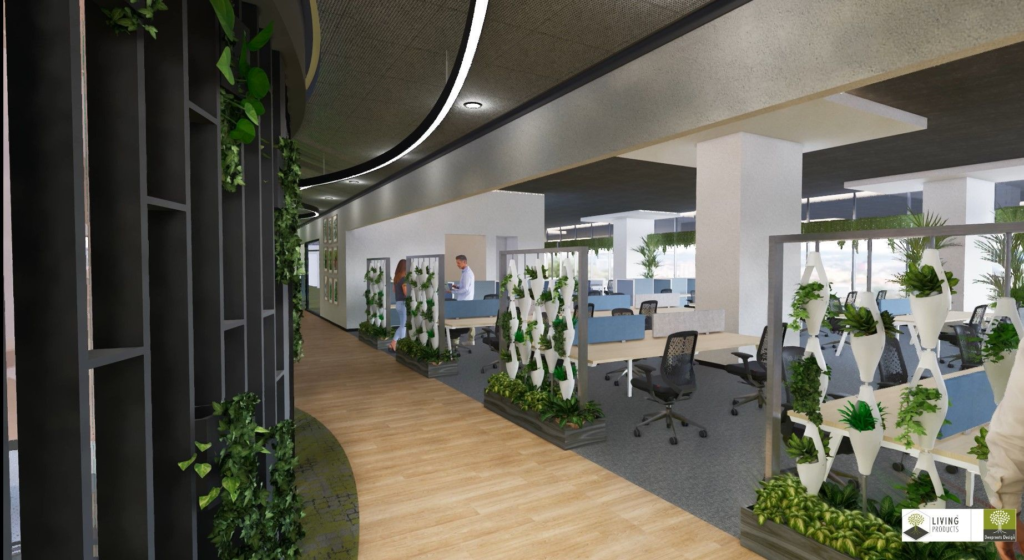‘The essence of interior design will always be about people and how they live’ ~ Albert Hadley
Do you know that Americans spend a major portion of their day sitting? According to a report by the American College of Sports Medicine, the average adult between the age group of 20-75 spends 9.5 hours of their day in a sedentary state (while working in front of digital devices).
While medical experts prove that we are biologically designed to move around in Nature and that indoor desk jobs increase the risk of adverse health conditions like high blood pressure, unhealthy cholesterol levels, obesity and so much more.
For instance, most construction jobs that we know take place outdoors. While they involve hard work, studies report that working among green trees, fresh air, and sunlight increases positivity, productivity, and creativity.
Due to this, future designers lean into the concepts of sustainability, well-being, flexibility, equity, and creating a balance with technology while creating office spaces. That’s how outdoor working gets into the picture.
Outdoor Working & Workspaces
After improved ventilation became the key ingredient in the office workspace post-COVID-19, interior designers, and landscape architects are focussing on outdoor work to create safe and productive outdoor workspaces.
Leading companies like LinkedIn experimented with outdoor work environments in August 2019 when they opened an experimental outdoor workspace in Sunnyvale, CA. A 17-foot-long central picnic-style work table with adjustable height chairs, permanent no-glare monitors, and retractable overhead shades became an inspiring and high-performing space for people who wanted to work outdoors.
How Healthy Are Outdoor Workspaces?
1. Employee Wellbeing
Spending time outdoors improves the overall well-being of the employees as it provides them a space to relax, take breaks and unwind in nature. According to a psychology study by the University of Michigan, attention spans and memory performance improves by 20% when people work in nature.
2. Mood Enhancer
According to Lisa Nisbet, Ph.D., a psychologist at Trent University in Ontario, Canada, ‘There’s mounting evidence, from dozens and dozens of researchers, that being close to Nature has both psychological and physical human wellbeing benefits’. Lisa studies connectedness to Nature and believes that a sense of connection with the natural world contributes to happy hormones (Serotonin & Melatonin) being secreted in your body.
3. Collaboration & Team Building
Fortunately, working in nature also leads to feelings of trust, teamwork, collaboration, and community. And, effective team building and teamwork are because of the cognitive and mental health advantages of outdoor working that every member feels.
4. Nature Heals
Workplaces with natural elements have 6% more productive workers, report a 15% higher level of well-being, and are 15% more creative than the rest, as reported by a study from Human Spaces ‘The Global Impact of Biophilic Design in the Workplace’.
This sudden increase in operational productivity is because of improving the human connection to Mother Nature.
5. A Balm For Your Busy Brains
Experimental and correlational research shows that nature has cognitive advantages. A Chicago psychologist, Marc Berman, PhD explored that green spaces near schools promote cognitive development in children. Furthermore, green views near children’s homes and neighborhoods promote self-control behaviors. Being exposed to natural environments improves –
- Working memory
- Cognitive flexibility
- Attention control
And so much more.
How Deeproots Design Exemplifies Work In Nature?
Origin Energy, Australia
Deeproots Design designed their rooftop terrace using sustainable design principles, native low-maintenance planting, free plants & materials, sustainable ideology, innovative outdoor products, and eco-friendly building materials. Designed for recreational activities, team meetings, etc for the staff, it’s designed as a part of Patio landscape architecture in Sydney.

Bagmane Rio Campus, Bengaluru
Deeproots Design constructed a natural environment to create optimal outputs with features like relaxed listening to the chirping of birds and watching the fluttering butterflies or taking in the fragrance around.

Want to see how Deeproots Design transformed workplaces with landscape architecture? Check it out here!
Connect with us to add green spaces around you!
